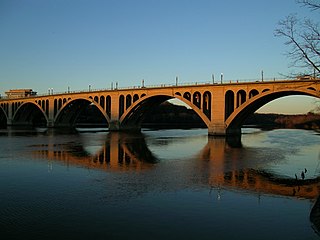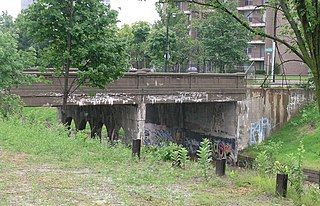
The Yaquina Bay Bridge is an arch bridge that spans Yaquina Bay south of Newport, Oregon. It is one of the most recognizable of the U.S. Route 101 bridges designed by Conde McCullough and one of eleven major bridges on the Oregon Coast Highway designed by him. It superseded the last ferry crossing on the highway.

The Francis Scott Key Bridge, more commonly known as the Key Bridge, is a six-lane reinforced concrete arch bridge conveying U.S. Route 29 (US 29) traffic across the Potomac River between the Rosslyn neighborhood of Arlington County, Virginia, and the Georgetown neighborhood of Washington, D.C. Completed in 1923, it is Washington's oldest surviving road bridge across the Potomac River.

The American Legion Memorial Bridge, also known as the South Cass Street Bridge, is a reinforced concrete arch bridge carrying South Cass Street over the Boardman River in Traverse City, Michigan. It was completed in 1930 and listed on the National Register of Historic Places in 2000.

The Lamar Boulevard Bridge is a historic arch bridge carrying Texas State Highway Loop 343 over Lady Bird Lake in downtown Austin, Texas, United States. The bridge features six open-spandrel concrete arches spanning 659 feet (201 m) and carries tens of thousands of vehicles daily across the lake. Completed in 1942, the Lamar Boulevard Bridge was the second permanent bridge to cross the Colorado River, and one of the last Art Deco-style open-spandrel concrete arch bridges built in Texas. The bridge was named an Austin Landmark in 1993 and added to the National Register of Historic Places in 1994.
The South Dakota Department of Transportation (SDDOT) is a state government organization in charge of maintaining public roadways of the U.S. state of South Dakota. South Dakota has 82,447 miles of highways, roads and streets, as well as 5,905 bridges. The SDDOT is responsible for 7,830 miles of the roadway system.

The Chestnut Street Bridge is located where Chestnut Street passes over the Dequindre Cut in Detroit, Michigan. It was listed on the National Register of Historic Places in 2000.

The Arrawanna Bridge is a historic bridge, spanning the Coginchaug River near Berlin Street in Middletown, Connecticut, USA. Built in 1918, it is an early example in the state of an open-spandrel concrete arch bridge, and is one of the state's oldest bridges. It was listed on the National Register of Historic Places in 2004. The bridge is now closed to all traffic.

The West Park Bridge across the Sheyenne River in Valley City, North Dakota is a concrete false arch structure that was built in 2007. Together with the corresponding East Park Bridge, it brings Valley City's 4th Street across an oxbow of the Sheyenne River. The bridge is a sympathetic replacement for a historic bridge, built in 1924, that was listed on the National Register of Historic Places in 1997.

The West Second Street–Swartz Creek Bridge in Flint, Michigan, carries West Second Street over Swartz Creek. It was listed on the National Register of Historic Places in 1999.

Bridge No. 1860, also known as the Samson Occom Bridge, is a fieldstone arch bridge in Montville, Connecticut, United States. Constructed by the Connecticut State Highway Department in 1936 as a Works Progress Administration project, it is located on Mohegan tribal land in an area that was once a part of Fort Shantok State Park. The bridge carries traffic from Massapeag Side Road over the Shantok Brook, a tributary of the Thames River. Spanning 12 feet (3.7 m) across the brook, the bridge's arch rises about 6 feet (1.8 m) above the water. According to a 2011 Connecticut Department of Transportation report, it carries 1,100 vehicles per day. Samson Occom Bridge was listed on the National Register of Historic Places in 1993.

The Gilsum Stone Arch Bridge carries Surry Road over the Ashuelot River in Gilsum, New Hampshire. Built in 1862–63, it is one of the highest stone arch bridges in the state. It has a span of 47 feet 8 inches (14.53 m), and an average height over the river of 36 feet 6 inches (11.13 m). The roadway is 43 feet 6 inches (13.26 m) above the riverbed. It stands on the site of four previous bridges, where the river passes through a deep gorge. The previous bridge was also a stone arch bridge, which was built in 1860 and collapsed a few months later. It was designed by William Leonard Kingsbury, a local official; its builders are not known because the town's records were destroyed in a fire. The present bridge's vault is carefully constructed from dry-laid granite voussoirs that were shaped for a very precise fit, with larger stones at the lower ends of the arch, and a smaller ones at the crown. Some of the stones were left with rough surfaces, while others were hammered smooth.
The South Dakota Dept. of Transportation Bridge No. 48-244-204 is a historic bridge over the Little White River just west of White River, South Dakota. At 314 feet (96 m) in length, it is the longest concrete slab bridge in the state. It was built in 1934 to carry South Dakota Highway 44 across the river, but now carries a local road north of that road's current alignment. The bridge consists of eighteen concrete slabs, each 16 feet (4.9 m) in length, resting on a series of concrete piers, with wing-walled concrete abutments at both ends.
South Dakota Dept. of Transportation Bridge No. 49-095-190 is a historic bridge in rural Miner County, South Dakota. It carries a local road over Rock Creek, about 6 miles (9.7 km) south and 6.5 miles (10.5 km) west of Howard. Built in 1917, it is the longest pre-1920 concrete slab bridge in the state. Bridges from this time predate the standardization in the methods and use of concrete in bridge construction, and are relatively rare. The bridge consists of a single span 27 feet (8.2 m) in length, with a solid concrete parapet as a railing. The concrete is suffering from spalling.

The Melan Bridge is located in Emma Sater Park on the east side of Rock Rapids, Iowa, United States. The 30-by-16-foot structure is believed to be the third reinforced concrete arch span built in the country. Austrian engineer Josef Melan developed a new system of concrete reinforcement for bridge construction in the early 1890s. A fellow Austrian, Fritz von Emperger, introduced the system in the United States, and obtained a patent for it in 1893.

The West Sixth Street Bridge is a historic stone arch bridge in downtown Austin, Texas. Built in 1887, the bridge is one of the state's oldest masonry arch bridges. It is located at the site of the first bridge in Austin, carrying Sixth Street across Shoal Creek to link the western and central parts of the old city. The bridge was added to the National Register of Historic Places in 2014.
The Minnesela Bridge is a historic bridge located in Butte County, South Dakota. Formally known as South Dakota Department of Transportation Bridge No. 10-114-395, it passes over Redwater Creek about 1.5 miles (2.4 km) southeast of Belle Fourche. It was built in 1917 and was listed on the National Register of Historic Places in 1993 as part of the Historic Bridges in South Dakota Multiple Property Submission. It was one of the earliest concrete bridges constructed in the state. Concrete Engineering Company built multiple concrete bridges in the Rapid City area in the late 1910s, and due to the quality of their construction, many have survived. The bride was built at a cost of $2,588. Its common name is in reference to the nearby site of the ghost town of Minnesela, which sits just a few feet east of the bridge.
The Hay Creek Bridge in Belle Fourche, South Dakota was built in 1941. It was listed on the National Register of Historic Places in 1993.
Spring Valley Township Bridge No. E-31 is a historic bridge in rural Turner County, South Dakota, carrying 447th Avenue across unnamed stream west of Viborg. Built in 1938, it was a well-preserved example of a stone bridge built for the county with funding from the Works Progress Administration. It was listed on the National Register of Historic Places in 1999.

The Mill Street–South Branch Raisin River Bridge is a bridge carrying Mill Street over the South Branch of the River Raisin in Brooklyn, Michigan. It was listed on the National Register of Historic Places in 2000.

The West Fifth Street Bridge is a historic cantilever concrete girder bridge in downtown Austin, Texas. Built in 1931, the bridge carries Fifth Street across Shoal Creek to link central Austin with neighborhoods that were then the city's western suburbs. It is one of only a handful of curved cantilever girder bridges in Texas, built as part of the city's 1928 master plan for urban development and beautification. The bridge was added to the National Register of Historic Places in 2019.

















